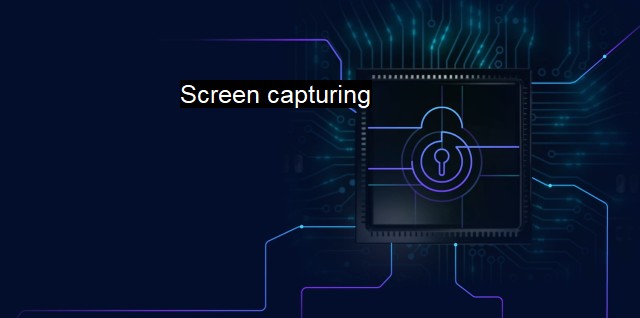What is Screen capturing?
The Importance of Screen Capture Technology in Cybersecurity and Antivirus: Uses, Types, and Risks
Screen capturing is a widely used functionality that allows users to grab and store a digital image of what is displayed on an individual's computer screen. This function can bring numerous conveniences on many occasions. For instance, trainings and presentations often employ screen captures to illustrate procedures; individuals use captures to share amusing graphics from social media, help in trouble-shooting by showing the error messages or track progress in an application. Despite its seeming innocuous nature, to cybersecurity, screen capturing could be a deeply troubling matter.The becoming issue herein is when this functionality is misused with malicious intent often overspread by unethical hackers or intrusive software – Abstractly referred to as 'screen capture malware'. The screen capture malware is a rogue code designed to remotely capture what's on the user's computer screen in real-time, thereby breaching the user's privacy.
Their mechanism is stark. Screen capture malware, often camouflaged within seemingly harmless software, is stealthily installed onto a target device. Once infiltrated, it operates discretely in the background. It captures screen content periodic or continuous, depending on its sophistication and sends it back to the ultracrepidarian hacker. Sensitive information, which could be anything from passwords, credit card information, intellectual property, official documents or personal photos, when mishandled by wrong hands, proves potentially catastrophic. Hence, unaware victims of such rogue functionality stand at a liaison of identity theft, financial losses, privacy breaching and corporate espionage.
Screen capturing is one of the highly insidious forms of a malware attack - alongside keystroke logging and remote access toolkits. These forms elude the naked eye by entering through authorized access channels or imitation of authorized software. To detect such malware, competent antivirus software is quintessential.
In modern cyber-age, antivirus software is as crucial as the Internet itself. Antivirus software continuously monitors the device for malicious activities, providing real-time protection. It can identify, block and neutralize the threats and helps keep sensitive information safe by ensuring computer hygiene.
Advanced antivirus software are equipped to tackle screen capturing malware. Colossally, they detect the malware by signature-based detection, where known malware is identified based on a specific set of attributes or 'signature'. Contrarily, for unknown or zero-day malware, heuristic detection methods apply which identifies malware based on behavior or characteristics. A sudden hike in CPU usage, data transmission spikes or delay in screen refresh rate, indicate possible penetrations; a heuristic method reels into action based on these coenaesthetics creating generic signatures.
Retrospectively, the antivirus holds the breach, alerts users and often quarantines the malware preventing further spread. Some antiviruses have defense mechanisms like intrusion detection/prevention system, sandboxing technique or exploitation blocking, which prevents rogue software from capturing screen.
Consider, even with top-notch antivirus software, zero percent vulnerability is unrealistic. Continuous updates, patching of software applications, increasing user awareness and robust, multi-tier security protocols are also formidable defenses. Cybercriminals relentlessly create advanced malware premeditating the proactivity of antivirus software.
Conclusively, while screen capturing eases digital life, it's misuse - constituted by screen capturing malware jeopardizes personal security posing immense risk to confidential data and privacy. Antivirus software, as a conduit of computer health, can't be disregarded. Balancing the act between convenience and safety, would minimalize the repercciouns of this risk. Cybersecurity is like an endurance race where sprints of infiltrations combated by ceaseless vigilance makes triumphant sense – an ideation gangling over software firewall and antivirus into the everyday life of cognizant netizens.

Screen capturing FAQs
What is screen capturing in the context of cybersecurity?
Screen capturing in cybersecurity refers to the process of recording screen activity on a device or computer system. This process can be used for various purposes, such as monitoring employee activity, detecting suspicious behavior, or capturing evidence of cyberattacks.Why is screen capturing important for antivirus?
Screen capturing is important for antivirus because it allows antivirus software to detect and stop malicious activity on a device. By capturing and analyzing screen activity, antivirus software can identify and block suspicious applications or behaviors that may indicate a cyberattack or malware infection.Is screen capturing legal in the context of cybersecurity?
In most cases, screen capturing is legal in the context of cybersecurity, as it is often used for legitimate security purposes such as monitoring employee activity or detecting cyber threats. However, there are some legal and ethical considerations that must be taken into account, such as privacy laws and data protection regulations.What are the risks associated with screen capturing in cybersecurity?
The risks associated with screen capturing in cybersecurity include potential privacy violations, data breaches, and legal issues if proper consent or regulations are not followed. Additionally, screen capturing can be resource-intensive and impact device performance if not properly managed. To minimize these risks, it is important to use screen capturing tools and techniques that are secure, compliant, and ethical.| | A | | | B | | | C | | | D | | | E | | | F | | | G | | | H | | | I | | | J | | | K | | | L | | | M | |
| | N | | | O | | | P | | | Q | | | R | | | S | | | T | | | U | | | V | | | W | | | X | | | Y | | | Z | |
| | 1 | | | 2 | | | 3 | | | 4 | | | 7 | | | 8 | | |||||||